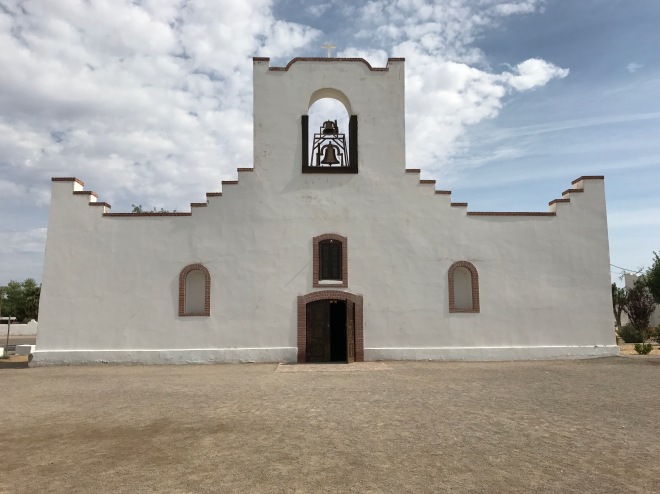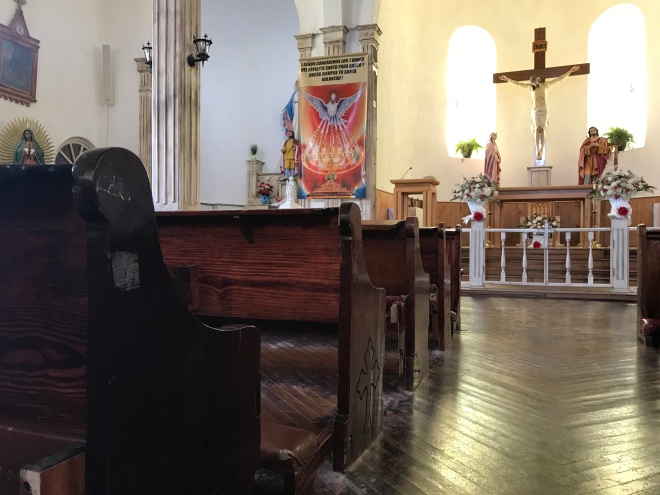When it comes to outdoor adventures in the Lone Star State, the Franklin Mountains have much to offer. Franklin Mountains State Park is located at the westernmost tip of Texas and is the largest urban park in the nation. The park encompasses more than 26,000 acres in the city of El Paso, and yet once in the park, you would never know you were anywhere near a city.
 The Franklin Mountains are roughly three miles wide by twenty-three miles long and divide the city of El Paso. The range rises to an elevation of more than 7,000 feet above sea level and offer some of the best hiking and biking trails in Texas. The state park has some of the best camp sites of any state park — every one with a beautiful view of the mountains.
The Franklin Mountains are roughly three miles wide by twenty-three miles long and divide the city of El Paso. The range rises to an elevation of more than 7,000 feet above sea level and offer some of the best hiking and biking trails in Texas. The state park has some of the best camp sites of any state park — every one with a beautiful view of the mountains.
 The Aztec Cave Trail is one of the most popular hiking trails in the park. According to local lore, early El Pasoans reportedly found bones and other Native American artifacts in the caves. However, they mistakenly concluded that the early inhabitants were Aztecs and the caves soon became known as the Aztec Caves.
The Aztec Cave Trail is one of the most popular hiking trails in the park. According to local lore, early El Pasoans reportedly found bones and other Native American artifacts in the caves. However, they mistakenly concluded that the early inhabitants were Aztecs and the caves soon became known as the Aztec Caves.
 The trail to the caves is not long but it is steep. The trail is well-marked and well-maintained. There are a couple of primitive campsites along the way for visitors who want to spend the night at campsites located a bit higher than the other sites at the park. These are definitely bring your own water sites.
The trail to the caves is not long but it is steep. The trail is well-marked and well-maintained. There are a couple of primitive campsites along the way for visitors who want to spend the night at campsites located a bit higher than the other sites at the park. These are definitely bring your own water sites.
 At about a half-mile into the hike, the trail becomes increasingly steeper but very manageable for hikers. I hike with trekking poles which make sections like this a bit easier to negotiate. The payoff at the end of the trail makes the hike absolutely worth it all. Once you arrive at the caves it is easy to understand why native peoples were drawn to places like this.
At about a half-mile into the hike, the trail becomes increasingly steeper but very manageable for hikers. I hike with trekking poles which make sections like this a bit easier to negotiate. The payoff at the end of the trail makes the hike absolutely worth it all. Once you arrive at the caves it is easy to understand why native peoples were drawn to places like this.
 The view from the caves is absolutely magnificent. The ceiling of the main cave is stained by smoke, evidence that ancient peoples once spent time here and enjoyed the same beautiful vistas that visitors today enjoy. I’m glad that sites like this have been preserved by the Texas Parks and Wildlife system for us and future generations to enjoy.
The view from the caves is absolutely magnificent. The ceiling of the main cave is stained by smoke, evidence that ancient peoples once spent time here and enjoyed the same beautiful vistas that visitors today enjoy. I’m glad that sites like this have been preserved by the Texas Parks and Wildlife system for us and future generations to enjoy.
 If you enjoy hiking you will definitely enjoy the Aztec Cave Trail and the several other trails at Franklin Mountains State Park. If I lived in El Paso I would make it a point to visit and hike these trails as often as possible. As for me, I am already making plans to return to the Franklin Mountains to hike again.
If you enjoy hiking you will definitely enjoy the Aztec Cave Trail and the several other trails at Franklin Mountains State Park. If I lived in El Paso I would make it a point to visit and hike these trails as often as possible. As for me, I am already making plans to return to the Franklin Mountains to hike again.
El Paso
El Paso Mission Trail
El Paso may not be located deep in the heart of Texas but it is a city with Texas deep in its heart. This westernmost city in the Lone Star State is unquestionably rich in history. A lot of that history was made along an eight mile stretch of road that was a part of the Camino Real.
The Camino Real, or Royal Road, was a major route for transporting trade goods from Mexico City and Chihuahua in the South to Santa Fe and Taos to the North. Three of the oldest mission churches in the country were established along this route on the frontier with Mexico.
 The Ysleta Mission is located closest to present-day El Paso. It is the oldest mission in Texas and the second oldest continually active parish in the United States. Established in the heart of Tigua Indian territory in 1680, the original mission was made of cottonwood branches and adobe mud.
The Ysleta Mission is located closest to present-day El Paso. It is the oldest mission in Texas and the second oldest continually active parish in the United States. Established in the heart of Tigua Indian territory in 1680, the original mission was made of cottonwood branches and adobe mud.
 Over the years the building was modified, enlarged, and improved — at times because of damage done by fires and floods. Today, the thick adobe-walled building stands as a testimony to the resolve of parishioners to continue to worship and practice their faith.
Over the years the building was modified, enlarged, and improved — at times because of damage done by fires and floods. Today, the thick adobe-walled building stands as a testimony to the resolve of parishioners to continue to worship and practice their faith.
 The Socorro Mission is located a short distance to the southeast of Ysleta and is considered the second oldest mission in Texas. Socorro is the Spanish word for help, relief, or assistance. Completed in 1691 to minister to Spaniards and also to the Piro, Tano, and Jemez Indians, this mission continues to live up to its name.
The Socorro Mission is located a short distance to the southeast of Ysleta and is considered the second oldest mission in Texas. Socorro is the Spanish word for help, relief, or assistance. Completed in 1691 to minister to Spaniards and also to the Piro, Tano, and Jemez Indians, this mission continues to live up to its name.
 Through the years, the building suffered many of the same disasters as the Ysleta Mission. And, like the Ysleta community, the folks at Socorro came to the aid of their parish. The building that stands today was built in 1843 and features design inspired by both the Indians and the Spanish. The carved support beams are made of cottonwood and cypress and were salvaged from the original building.
Through the years, the building suffered many of the same disasters as the Ysleta Mission. And, like the Ysleta community, the folks at Socorro came to the aid of their parish. The building that stands today was built in 1843 and features design inspired by both the Indians and the Spanish. The carved support beams are made of cottonwood and cypress and were salvaged from the original building.
 The third mission on the El Paso Mission Trail is the San Elizario Presidio Chapel. In 1789, Spaniards established a presidio or fort to defend the frontier and supply lines. This presidio was named “San Elceario” after the French patron saint of the military, San Elcear. A chapel was built within the presidio walls and bears the same name as the military garrison.
The third mission on the El Paso Mission Trail is the San Elizario Presidio Chapel. In 1789, Spaniards established a presidio or fort to defend the frontier and supply lines. This presidio was named “San Elceario” after the French patron saint of the military, San Elcear. A chapel was built within the presidio walls and bears the same name as the military garrison.
 Like the other early mission churches, the architecture of the San Elizario chapel is characterized by the adobe style that has become iconic in the southwest. I love these old structures that have endured for so long and have meant so much to their respective parishioners through the years.
Like the other early mission churches, the architecture of the San Elizario chapel is characterized by the adobe style that has become iconic in the southwest. I love these old structures that have endured for so long and have meant so much to their respective parishioners through the years.
 There are lots of great things to do in El Paso, including driving the Mission Trail along Socorro Road. Each of these old missions welcome visitors. So, add this to your list of Texas adventures. You will enjoy learning about the role each of these missions and their parishioners have played through the years in the development of this part of the Lone Star State.
There are lots of great things to do in El Paso, including driving the Mission Trail along Socorro Road. Each of these old missions welcome visitors. So, add this to your list of Texas adventures. You will enjoy learning about the role each of these missions and their parishioners have played through the years in the development of this part of the Lone Star State.
